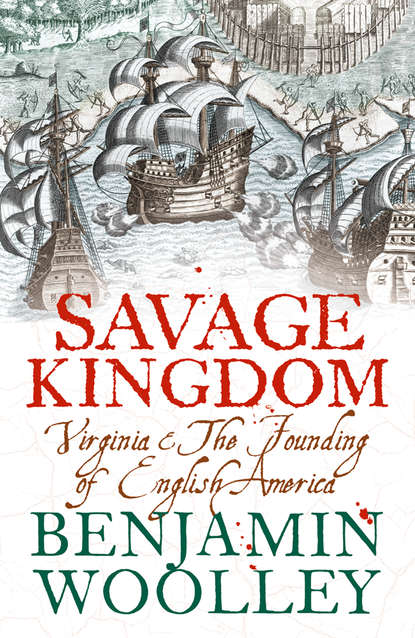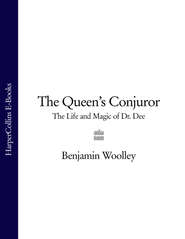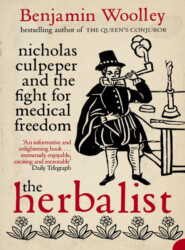По всем вопросам обращайтесь на: info@litportal.ru
(©) 2003-2024.
✖
Savage Kingdom: Virginia and The Founding of English America
Настройки чтения
Размер шрифта
Высота строк
Поля
(#litres_trial_promo)
Percy’s snooty assessment of this social inferior probably arose from White’s decision, soon after Newport’s fleet had first sailed up the James, to jump ship and join the Indians. He was one of several ‘renegades’ who understandably found the prospect of life with the Indians preferable to the dangers and depredations of the English camp.
(#litres_trial_promo)
The renegades were rarely mentioned in official records or letters home. Their very existence was not officially recognized until 1612, when a regulation was introduced making it a capital offence to live without permission in the town of ‘any savage weroance’.
(#litres_trial_promo) The conspiracy of silence arose out of a combination of envy and resentment. When they slipped from the settlement, the renegades entered into the feverish imaginations of those left behind. They became voices from beyond the veil of trees and vines, taunting the settlers for putting up with such hardships, ridiculing English assumptions of cultural and technological superiority, beckoning their former comrades to drop their tools, and wander through the woods into the alluring Indian embrace.
White had somehow fallen into that embrace. He ended up ten miles upstream of Jamestown, at the town of Quiyoughcohannock, visited by the English during their first reconnaissance of the river. It sat on a high bluff overlooking the James (modern Claremont, Virginia). Its name meant ‘priest of the river’, and it served as the religious centre for those living along the banks. This may have been why its people were so curious about the English and their religion, and why they welcomed the nervous, bewildered interloper who had come among them.
(#litres_trial_promo)
White would have been placed in the care of one of the senior women of the village, probably Oholasc, the stately queen of the Quiyoughcohannock, the most ‘handsome a savage woman as I have seen’, an English admirer noted. She was raising a son named Tatacoope, whose father was believed to be the mamanatowick Powhatan. Tatacoope was heir to the village chief, Pepiscuminah, or ‘Pipisco’, as the English called him. But Pipisco was in disgrace, having ‘stolen away’ one of Opechancanough’s wives. For this impertinence, he had been exiled to a nearby settlement, ‘with some few people about him’, including the offending woman. As a result, Chaopock, who was Pipisco’s brother from the neighbouring village of Chawopo, had been made acting weroance until Tatacoope came of age.
(#litres_trial_promo)
Life for White in the court of this great queen would have been comfortable, at least compared to the conditions being endured at Jamestown. Just being part of a rhythm of daily life was a relief, particularly among such positive people. White noted that before dawn, the men and women, together with children older than ten years, would leave their beds and run down to the river. There they would bathe and wash, and await the sun’s arrival sitting on the bank, within a circle of dried tobacco leaves, such was their delight in the coming of a new day.
(#litres_trial_promo)
After these daily ablutions, mothers would set out the breakfast, and summon their youngest boys to come to them with their toy bows and arrows. Only when they had managed to shoot a piece of moss tossed into the air could they tuck into a meal typically comprising boiled beans, fresh fish and corn bread, garnished with venison if the hunting was good. Older boys then went off with their fathers, to learn how to weave weirs and nets to catch fish, or to stalk game and butcher carcasses.
(#litres_trial_promo)
And so one day passed into another, until White began to notice this idyll’s fragilities. In recent years, hunting had been bad. For reasons that mystified the Indians, the deer population in the vast woodlands surrounding the river was dwindling. As supply continued to shrink, demand was becoming desperate, if only to fulfil an annual tribute demanded by the mamanatowick Powhatan. Adding to the pressure was concern about a continuing lack of rain. The village store of corn and beans was running low, but the plants in the fields were not yet a foot high, suffering from the second year of a drought more extreme than even the elders could recall.
(#litres_trial_promo)
The Quiyoughcohannock weroance Chaopock was also concerned about the amount of loot rival chiefs across the river were extracting from the starving English. The blue beads, copper and glittering minerals being offered in an ever greater multitude were valuable as symbols of chiefly power, and good substitutes for venison as tributes to offer Powhatan. The circumstances that had led to Chaopock’s promotion to chief made him sensitive about matters of status, and going to the English with his begging basket would be demeaning. But, with so many of his fellow weroances proving so greedy for the interlopers’ wares, Chaopock felt he had no choice but to go downriver to see what he could get. He went sometime in the summer, and returned a few days later, showing off a bright red waistcoat presented to him by the English weroance, Wingfield.
(#litres_trial_promo)
Then the English were forgotten, as the village became preoccupied with internal matters. White had no idea what was going on, but frantic preparations signalled an important and rare event. The first sign that it was taking place was the appearance of community leaders in heavy make-up. ‘The people were so painted that a painter with his pencil could not have done better,’ White noted. ‘Some of them were black like devils, with horns and loose hair, some of divers colours.’
One day, White awoke to find the town deserted. Probing the surrounding woodland, he discovered the entire community congregating in a clearing, preparing for some grand event. There followed two days of frantic dancing, intensifying the mood of anticipation. The horned satyrs, carrying tree branches in their hands, danced in a quarter-of-a-mile circle around the village fire, one group moving in the opposite direction to the other, both emitting a ‘hellish noise’ when they met. The branches were then thrown to the ground, and the satyrs ‘ran clapping their hands into a tree’, from which they would tear another branch. Anyone who lagged behind was beaten by Chaopock’s personal guard with a ‘bastinado’ or cudgel made of tightly packed reeds. ‘Thus they made themselves scarce able to go or stand.’
On the third day, fourteen strong boys aged ten to fifteen years, painted white from head to foot, were led into the village’s central arena. For the rest of the morning, the adults danced around them, shaking rattles. In the afternoon, women arrived with dry wood, mats, skins and moss. White, with a growing sense of foreboding, noted that they had also brought funerary goods used in the preparation of corpses. The women then began a terrible wailing.
The boys were led to the foot of a tree, where they were made to sit, watched by warriors brandishing bastinados. Presently, a guard formed up into two lines facing each other, creating a path leading from where the boys were sitting to another tree. Five young men dressed as priests were allowed to fetch the boys one by one, and lead them along the path. As they went, the guards subjected them to a hail of blows, forcing the priests to shield the boys with their naked bodies, ‘to their great smart’. Once all fourteen boys had been transferred from the foot of one tree to another, this ritualized abduction was repeated, then repeated a third time. Finally, the pummelling ceased, and the guards tore down the last tree under which the boys had been seated, and decorated themselves with its dismembered branches and twigs.
White could not make out what had happened to the boys in the midst of the mêlée, and it was at this point in the proceedings that he was asked to leave. Later, however, he glimpsed them again, somewhere near the torn tree. They were ‘cast on a heap in a valley as dead’. His shock was compounded by Chief Chaopock, standing ‘in the midst’ of them, summoning his warriors to bring wood to build a great pyre, ‘set like a steeple’. White was convinced that these were preliminaries to sacrificing the children ‘to the devil, whom they call Kewase [Okeus], who, as they report, sucks their blood’.
(#litres_trial_promo)
Later that day, everyone returned to their houses, as if nothing had happened. Okeus’s work with the Quiyoughcohannock was evidently done, and the frenzied, gruesome mood that had gripped the town was allowed to subside. The smoke of the smouldering town fire carried the wanton spirit away from the houses, through the trees and out on to the river, where it turned towards the bay, following the smell of fresh blood.
On 6 August 1609, a Jamestown settler named John Asbie succumbed to ‘the bloody flux’. His death marked the start of a month of mortality in the English fort.
Sickness and desertion were already rife. Supplies were all but spent. There was nothing left to drink, and in the absence of a working well, the men were forced to use the river, ‘which was at a flood very salt, at a low tide full of slime and filth, which was the destruction of many of our men’.
(#litres_trial_promo)
Rations from the ‘common kettle’ were ‘half a pint of wheat and as much barley boiled with water for a man a day, and this having fried some 26 weeks in the ship’s hold’. This put pressure on other sources of sustenance, including Wingfield’s flock of chickens. Only three survived to peck at the hard ground between the frail tents, when they were not being chased by ravenous labourers.
(#litres_trial_promo)
Responsibility for this sorry state of affairs has traditionally been laid at the feet of the English class system. Unlike the hard-working, clean-living Pilgrim Fathers who arrived in 1620, the ‘gentlemen’ who made up such a large proportion of Jamestown’s population have been portrayed as work-shy fops and dandies who ‘were used to social strata but not to discipline’, and who preferred the ‘narcissistic contemplation of heredity’ to getting their hands dirty.
(#litres_trial_promo)
In fact, most of the gentlemen of Jamestown had military backgrounds, and, while some hated the idea of heavy manual labour, they by no means saw themselves as due a life of ease.
Captain John Smith was himself a gentleman, and proud to be called so, advertising in his autobiography that the title had been endorsed by no less a figure than the King of Poland.
(#litres_trial_promo) Most of the others similarly classified had less heredity to contemplate than even Smith. He, at least, had a ‘competent means’ from his father and the patronage of a prominent member of the English nobility. Many had lived hard lives on the battlefields of the Low Countries, France and Ireland, or on the edge of destitution. Some were quite poor, the family of one military captain, for example, boasting an estate worth just twenty shillings.
(#litres_trial_promo) Perhaps one or two were feckless opportunists who preferred to rely on their charm and wits rather than honest toil to make a living. But their behaviour was a consequence of the relative lack of social privilege, not an excess of it. Similarly, they had not crossed the Atlantic and put themselves in the predicament in which they now found themselves because life at home had been so easy, but because it had been so hard.
Smith’s peers, particularly the squabbling council members, may have contributed to the settlement’s first crisis, but even he acknowledged that the damage they caused was collateral. The origin of Jamestown’s woes, at least in these early stages of settlement, lay in the simple lack of food. Calculations for provisioning the expedition had inevitably erred on the side of stinginess, with enough to cover a two-month crossing, and six more months in America while a planting of crops ripened, the fort was built, and trade relations with the Indians were established. According to this timetable, a harvest would be ready by the time the supplies started to run out, which could supplement, and ultimately replace, food bought from the Indians.
(#litres_trial_promo) Unfortunately, the crossing had taken not two months but five. This triggered a cascade of problems: by the time they arrived, the planting season had been all but missed, so there was no hope of a proper harvest in August; the crews of the Susan Constant and the Godspeed, who were due to return to England, had run out of their own supplies, so had to be fed out of the settlement’s store while Newport reconnoitreed the river. This left the settlers fewer than twelve weeks to acclimatize to their new surroundings and become self-sufficient.
(#litres_trial_promo)
Both at the time and since, critics have wondered why they could not live off Virginia’s natural resources, given the abundance apparently at their disposal. Smith, Archer, Percy and countless successors boasted about the fat vines and fruitful trees, the nuts and berries, the deer running through the forest and the rodents scampering in the undergrowth, the sturgeon in the river and the oysters on the shore. Could that not feed a hundred or so men, in the middle of summer? The Indians’ own experience demonstrates otherwise. Hunting, fishing and scavenging, which they performed with astonishing efficiency, provided only a third of their daily needs, averaged out over the year; the other two thirds coming from their staple crop of cultivated corn and beans. The English, being in an alien environment, were bound to rely on a staple crop to provide a much higher proportion of their diet – four fifths at least, which meant finding between one and two tons of corn every week, just to survive.
(#litres_trial_promo)
Back in June, there had been hopes that the Indians would make up the deficit. A messenger had arrived at the fort, claiming to be an emissary of the ‘Great Powhatan’. The mamanatowick wanted peace with the English, and ‘desired greatly’ their friendship. Furthermore, he had commanded all attacks on the fort to cease, so that the English ‘should sow and reap in peace’. If any Indians ignored this command, he would, he pledged, ‘make wars upon them with us’. ‘This message fell out true,’ Wingfield later observed, ‘for both those weroances have ever since remained in peace and trade with us.’ It was soon after this that Wingfield had been approached by the Quiyoughcohannock chief Chaopock, promising peace and offering food supplies in the autumn, for which Wingfield offered him his red waistcoat, knowing English clothes to be among the possessions most prized by the Indians.
However, peace with the Indians did not yield the hoped-for influx of food. Skirmishes continued with the Paspahegh, and a high level of mutual suspicion and misunderstanding made trading difficult with more distant towns.
By August, each man was receiving fewer than five hundred calories in his daily ration, and the result was a lethal combination of rampant disease and seething discontent. Rumours began to spread that some of the gentlemen, in particular the suspiciously healthy Wingfield, were hoarding private supplies. There was talk of the council hiding a stash of oil and alcoholic drink, and of the councillors’ ‘privates’ or favourites getting preferential treatment. One of the gentlemen, Jehu (or John) Robinson, was accused by Wingfield of plotting to seize the shallop and escape with associates to Newfoundland.
As the death toll began to rise, it became clear that social status provided little protection. Percy kept a doleful muster of the dead for those summer months, and it makes solemn reading: John Asbie, the first casualty, was followed two days later by George Flower, gentleman, who died ‘of the swelling’. Next was William Brewster, ‘of a wound given by the savages’, who was buried on 11 August.
August 14 was one of the worst days. Francis Midwinter, gentleman, and Edward Morris, ‘corporal’, died ‘suddenly’, and Jerome Alicock, the settlement’s standard-bearer, was dispatched by a ‘wound’. A skeleton with a bullet-shattered shin was dug up at Jamestown nearly four hundred years later, raising speculation that it may have been Alicock. Another candidate is the following day’s casualty: Stephen Calthorp, the man who had been accused of instigating the ‘intended and confessed mutiny’ involving Captain Smith.
(#litres_trial_promo)
Over the following three days, four more settlers died, including John Martin, son of councilman John Martin senior. Martin senior had been confined to his tent for some time, his various ailments making him too weak to leave his sickbed. But bitterness over the death of his child stirred him into action, and he accused Wingfield of ‘defrauding’ his son of the rations he needed to survive.
A day later, Drew Pickhouse, an impoverished former Sussex MP, followed the others into a makeshift grave. He had hoped to find good fortune abroad, having lost his estate at home following a legal dispute with a local aristocrat. He had left behind a wife and eleven children, presumably in rented accommodation. They would not learn of his and their fate for another eleven months.
(#litres_trial_promo)
A two-day respite did not prepare the settlers for the most distressing death of all: that of Captain Bartholomew Gosnold on 22 August, after three weeks of illness. Just before Newport had taken his leave of the settlement to return to England, President Wingfield had confided that he feared only two rivals taking over the presidency, that ‘ambitious spirit’ Archer, who ‘would if he could’, and Gosnold, who was so ‘strong with friends and followers’ he ‘could if he would’. Now he could not, depriving the settlers of the one man who seemed to command the confidence and respect that might lead them out of their troubles and miseries.







